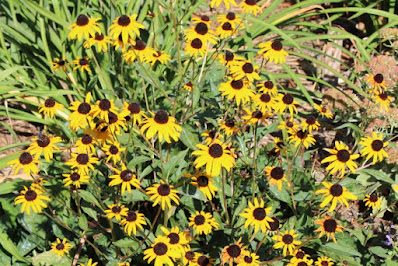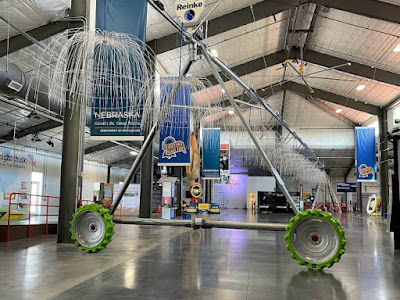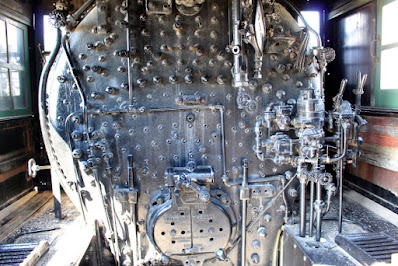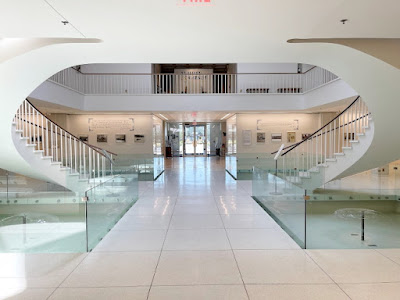Stolley Park in Grand Island contains the original Stolley House, along with the original log cabin post office, and the first school house in Grand Island. I could not figure why there was a rock structure on the property, so I asked a grounds keeper what it was used for. He explained that originally this site was a zoo and it was a viewing platform. As the City expanded, the zoo was moved to a different location and the site was developed as a park. It was after the zoo moved that the historic structures were relocated to this site.
On display in the Nebraska Building at Fonner Park is the largest pair of bib overalls in the world. The overalls were made by the Lee Company in 1930 for advertising purposes at the Nebraska State Fair. After the fair, the Lee Company just left the overalls and over time the overalls became part of the Nebraska State Exhibit. The overalls are 17.3-feet long with an 8.08-foot inseam and a 14.9-foot waist. The buttons are 8-inches in diameter.
One of the largest ears of corn in the world is also located in the building.
Since I was the only visitor in the building, they let me drive the John Deer combine simulator.
The Stuhr Museum complex consists of 107 buildings, located on 208 acres of land, and containing over 150,000 historic artifacts. The museums and grounds are open all year, but the 1892 Railroad Town Living History Experience is only open during the summer months. Due to the size of the property, it was recommended that I drive between the various exhibits. Good advice!
I started with the train display that contained steam locomotive No. 437, along with a passenger car and caboose.
Union Pacific's steam engine No. 437 was built by Baldwin Locomotive Works in 1901 at a cost of $15,068. The engine could haul 2,870 tons of freight and served on the Union Pacific mainline that ran through through Grand Island for about 20 years. After being replaced by larger locomotives, it served on branch lines until its retirement in 1956.
Not much is known about the wood passenger coach that was built in 1872. When this car was first put into service it had two restrooms and coal stoves for heat. Due to safety concerns, in the early 1900s the railroad started replacing the wooden passenger cars with newer cars that were constructed from steel.
The caboose on display was built in 1912 and is one of the few remaining wooden-bodied Union Pacific cabooses. It was retired from service in May 1960.
Located in front of the Gus Fonner Memorial Roundhouse is one of several bronze-casting sculptures that were made depicting the Martin Brothers as they fled an Indian attack. (More about the Martin Brothers in next week's blog.)
Within the Roundhouse museum there were various collections of cowboy and Indian artifacts, including early gaming devices used in the saloons. There was also an interesting map showing which Indian tribes occupied the various parts of Nebraska. The Pawnee Indians controlled the most land in central Nebraska.
Sited on an island in the middle of a lake is the beautiful Leo B. Stuhr Building that contains a collection of early Nebraska pioneer exhibits. The exhibits include a windmill fan, covered wagon and clothing, and a beauty shop women's hair curler that looked somewhat dangerous to use.
Driving around the property I discovered a Pawnee Village with a teepee and earthen lodge, 1980s farm, Immanuel Evangelical Lutheran Church, one-room schoolhouse (similar to the one I attended for 8 years), log cabins, Antique Autos & Farm Machinery Museum (closed), and 1892 Railroad Town (buildings were closed).
Before leaving Grand Island I stopped by Fred's Flying Circus to see The Peppermint Kid, Red Baron, Snoopy, Purple People Eater, Wild Rosey, Mayberry Cruiser, Hell on Wheels, Coney Car, Apple Kart Special, Big Mama's Cab Co. and others.
 |
| The Peppermint Kid |
 |
| Red Baron |
 |
| Snoopy |
 |
| Purple People Eater |
 |
| Wild Rosey |
 |
| Mayberry Cruiser |
 |
| Hell on Wheels |
 |
| Coney Car |
 |
| Apple Kart Special |
 |
| Big Mama's Cab Co. |






















































No comments:
Post a Comment